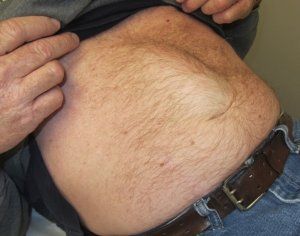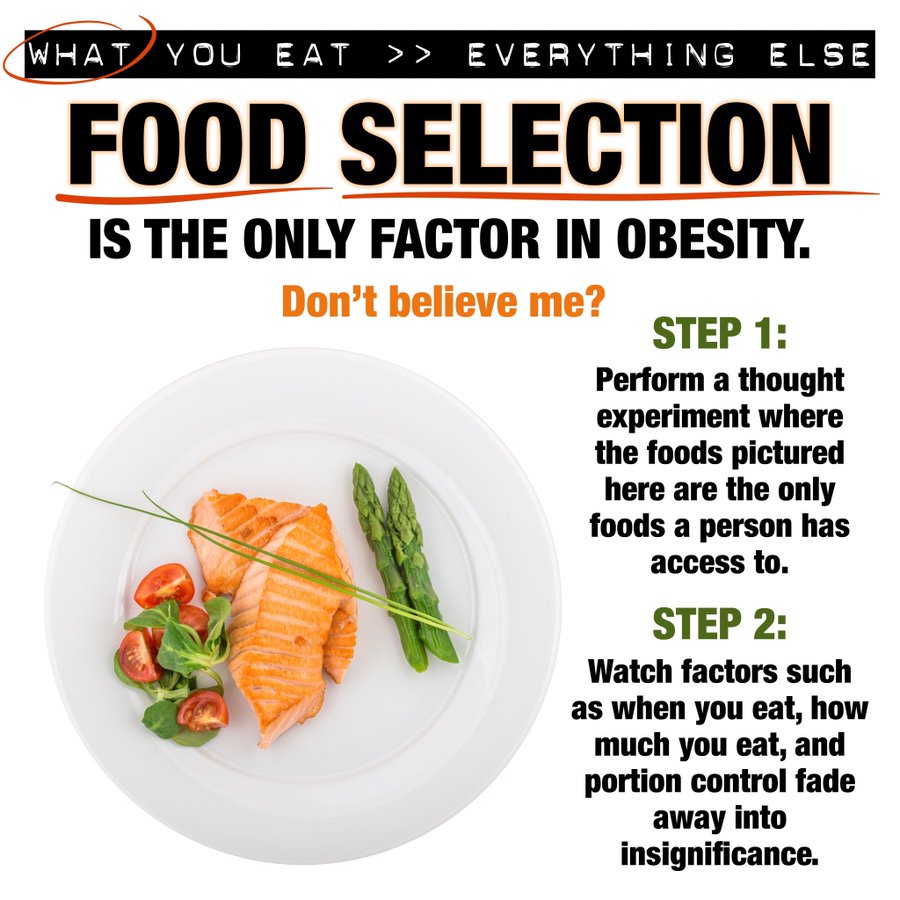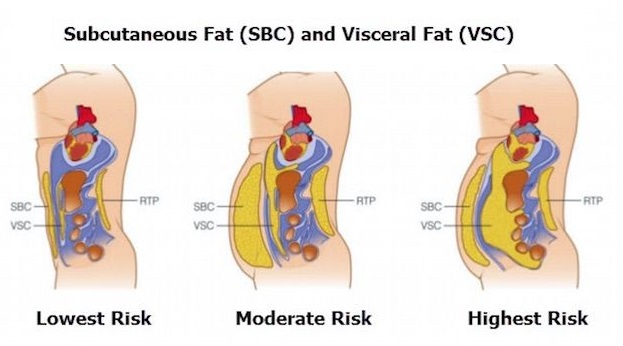Back pain and core strength from diastasis recti can be caused by visceral fat. Here’s how you can understand the role of poor metabolic health in diastasis recti, and what you can do about it.
A few decades ago, “diastasis recti” was a term known only to recent mothers. The changes in a woman’s body during pregnancy predispose them to overly flexible connective tissues. And the presence of the baby under the abdominal wall changes the mechanics of how the abdominal muscles behaved.
But in the past 30 years, diastasis recti has become increasingly prevalent in both women and men in middle age. Like non-alcoholic fatty liver disease (NAFLD), this relatively recent problem is driven by the metabolic damage which results from ultra-processed foods. In this article, I want to discuss exactly what diastasis recti is, and why it matters for our strength and our health. I’ll make the case that this condition is a sign of underlying health issues, and that it can predispose us to problems in our low back and trunk. I’ll then finish by outlining a solution.
What is Diastasis Recti, specifically?
Diastasis recti is a lateral separation or splitting of the “six-pack-abs” muscles on the front of our abdomen, which are called the rectus abdominis. I’m going to call this muscle the “abs” from now on, and speak in laymen’s terms about it’s function and anatomy. Like all muscles, the abs try to take the shortest path between their two bony attachments. They start at the bottom of the sternum and 5th through 7th ribs, and run downwards to the front of the pelvis (the pubic symphysis). You have a pair of abs which run in parallel, and are joined together by a very thin tendinous band of tissue called the linea alba (which means “white line).” The job of these “abs” is to bend the spine into flexion (a crunch), bringing your ribs and pelvis closer together in front of your body.

I mentioned the “shortest path” for a reason, because this is how diastasis recti develops. When a mass is placed under the ab muscles (most commonly a baby), the muscles no longer have an easy straight path downwards from the ribs to the pelvis. And since the connective tissues of a pregnant woman are already more stretchy, it is very common for the linea alba in between the abs to stretch and widen. This widening allows the ab muscles to simply detour out to the sides, going around the belly as they try to pull between the ribs and the pelvis.
Visceral Fat – the other cause of Diastasis Recti
There is another abdominal mass, however, that is increasingly common in western society. Like a pregnancy, it too can force the abdominal muscles to detour sideways around the belly. I’m talking about cases of diastasis recti caused by visceral fat, which accumulates under the abdominal muscles, around the organs, and is associated with a dysfunctional metabolism. This fat can’t be pinched or felt, like subcutaneous fat can. And in fact, it can be present under the abdominal muscle of a person who looks “skinny” and even has a firm, albeit slightly distended belly.

Particularly in men over 40, diastasis recti is an increasingly common problem that is caused largely by visceral fat. This problem has been described by some as a “ventral hernia,” (ventral means front) and can have the alarming look of a vertical bulge that appears up the middle of the belly when you try to sit up or do a crunch. In a sense, a weakening of the abdominal wall due to a sedentary lifestyle is a risk factor for hernia in general, so this “ventral hernia” idea isn’t entirely off-base.
But the issue is not a hole in the abdominal wall, as is the case with a true hernia. Rather, it is the stretching out of the linea alba as the ab muscles pull apart from each other in order to take the shortest path around the visceral fat.

Why does visceral fat develop?
In his excellent book, the PE Diet, Dr. Ted Naiman, MD, gives a really helpful way of understanding how and why visceral fat accumulates. Basically, everyone has a different ability to store extra calories as fat. Some people are “blessed” with many fat cells, and the ability to grow new fat cells. These people can store extra calories as fat for a very long time, gaining lots of weight in the form of subcutaneous fat, before metabolic dysfunction develops. In a sense, even though they may be frustrated that they gain weight easily, they are “lucky” in that their bodies can prevent the damage of excess calories for a long time before they run out of room.
Other people are “unlucky,” because even though they may remain thinner as they age, their inability to store the extra calories from ultra-processed foods means that metabolic damage can begin earlier for them. This paradox of the metabolically healthy but heavy person, and the metabolically dysfunctional thin person has confused the discussion around the very real dangers of excess calorie intake, making it seem like excess weight isn’t a health problem, though it is.
But this distinction is important because total body weight isn’t really a good indicator of whether visceral fat is accumulating, and neither is body mass index. Much better is waist-to-height ratio, and even better than that is be measured with a body composition tool like the InBody, which can tell you how much visceral fat you have, and whether it may be contributing to diastasis recti.
Regardless of which category one falls in, the fact remains that ultra-processed, hyperpalatable food motivates overeating. And once our “personal fat threshold” is reached, and we can’t store any more fat under our skin, we begin instead to store it around our organs. This is a sign of severe metabolic dysfunction. Once this process starts, diabetes, liver disease, and heart disease all become drastically more likely, so we should be aggressive about protecting our health by intervening at the earliest sign of visceral adipose accumulation.
How does Diastasis Recti affect core strength and stability?
This problem isn’t just cosmetic. As every pregnant women can attest, abdominal strength is hugely compromised when your abs change their orientation. Diastasis recti can make it difficult, or even impossible, to sit up from a reclined position. The result is that many men with this condition exhibit severely reduced core strength, which may predispose them to chronic back pain. When the abdominal muscles aren’t functioning correctly, it’s difficult for the body to stabilize the spine during activities involving bending and twisting.
Now, I want to be careful here – back pain is very complex, and “instability” is not the only reason, or even the main reason for backs to hurt. Many people have diastasis recti without back pain, and back pain is never a destiny one must accept. Furthermore, “fixing” instability is rarely as simple as doing spinal stabilization exercises.
However, if we have a clear physical issue that is quite literally preventing a muscle’s normal ability to work, it makes sense to address that if we are trying to optimize our health and function and reduce our risk of back pain. And if our backs do hurt, it behooves us to ensure we have good strength, which is not possible with poorly managed diastasis recti.
How do we fix diastasis recti?
There seem to be good exercises for addressing diastasis recti once there is no longer a mass in the abdomen. In pregnant mothers, we can’t do much about it before the baby has been born, though maintaining fitness throughout pregnancy can make it easier to heal afterwards. And in postpartum mothers, researchers at my alma mater showed that those who were regular exercisers are less likely to have diastasis recti.

To that end, really correcting diastasis recti is impossible until we first address any underlying metabolic dysfunction and eliminate the visceral fat. Luckily, there is good news. There is good evidence that visceral fat is the last stored and first burned, and only modest weight loss is necessary to significantly reduce it!
Once we make the dietary changes necessary to both control energy intake and resolve hormonal dysfunction, our body can start to burn visceral adipose quickly. Usually, this starts by eliminating ultra-processed foods that are easy to overeat, though diets that temporarily restrict carbohydrates and restrict eating times seem exceptionally effective. Switching to whole foods is the first step for most in improving health, because real food portion-controls itself.
Can exercise help fix diastasis recti?
In a follow-on article, I will discuss exactly how the abdominal muscles are best trained to promote a correction of diastasis recti. The good news is that it doesn’t have to be too complicated. But since the first thing we have to do is eliminate the visceral fat, the best exercises we can start with are those that support our diets in fixing metabolic dysfunction. This means high intensity interval training, like CAROL, and high intensity strength training, as we do at StrengthSpace. These glycogen depleting exercises alter the health of our metabolisms by changing how our bodies respond to food, without increasing our appetites. After these are checked off for the week, abundant walking can help with calorie management, but more importantly it helps us to sleep well which is also crucial for metabolic health.
If this description of diastasis recti seems familiar, don’t waste your time looking for the magic exercise. Instead, take the first steps to really work on the quality, quantity, and timing of the food you eat. I strongly recommend Ted Naiman’s book, the PE Diet, and working with a coach can be a huge help for building the habits and systems needed to succeed.


This is a great article and very helpful. For someone who has little time for meal prep let alone cooking the options are more difficult. However certain grocery stores have ready to heat and eat “healthy” meals ( i.e. Salmon with asparagus, etc.) but the ingredients still read like the legal disclosure at the bottom of many commercials. A lot of “preservatives” seem to be included even though the food only has a couple day shelf life. What about quality protein supplements Like [#####] protein powder products to help get the protein needed when exercising a lot? Do these protein shakes typically contain ingredients that may make losing visceral fat difficult?
Jim,
Protein supplements can be a great way to control your appetite and support muscle growth and maintenance. Of course, be conscious of the ingredients.
I personally like Levels Whey, but a whey isolate might be a better bet to reduce the possible exposure to lactose or casein, if a person has a particular problem digesting those components of dairy products.